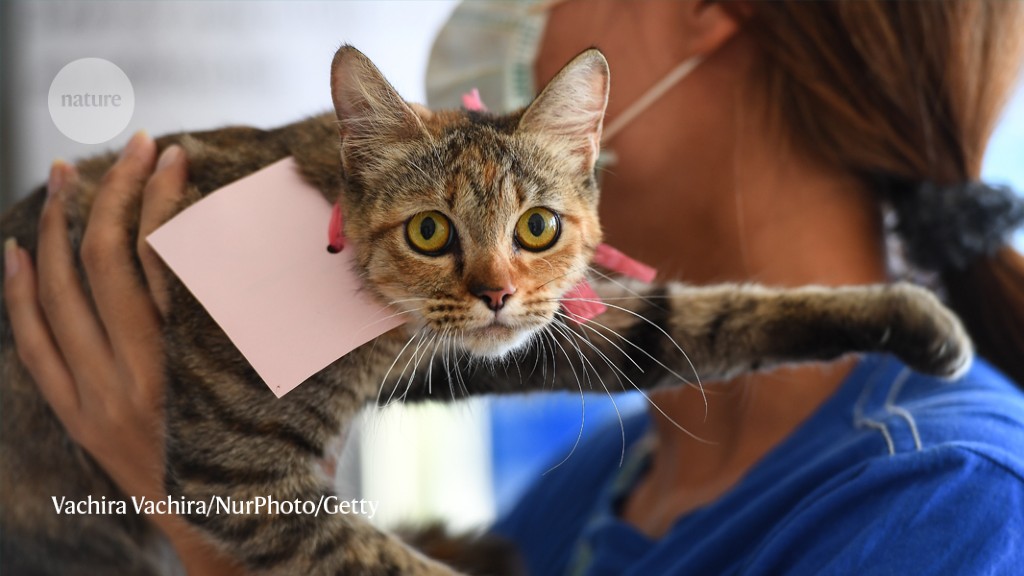- July 14, 2022
- No Comment
- 9 minutes read
COVID from a cat, pandemic death tolls and viruses that alter body odour – Nature.com

Thank you for visiting nature.com. You are using a browser version with limited support for CSS. To obtain the best experience, we recommend you use a more up to date browser (or turn off compatibility mode in Internet Explorer). In the meantime, to ensure continued support, we are displaying the site without styles and JavaScript.
Advertisement
You have full access to this article via your institution.
Cats can catch and transmit SARS-CoV-2.Credit: Vachira Vachira/NurPhoto/Getty
A team in Thailand has reported the first solid evidence of a pet cat infecting a person with SARS-CoV-2.
Studies early in the pandemic found that cats shed infectious virus particles and can infect other cats. And over the course of the pandemic, countries have reported SARS-CoV-2 infections in dozens of pet cats. But establishing the direction of viral spread — from cat to person or person to cat — is tricky.
Last August, a father and son who had tested positive for SARS-CoV-2 were transferred to a hospital isolation ward. Their ten-year-old cat was swabbed and also tested positive. While being swabbed, the cat sneezed in the face of a veterinary surgeon, who was wearing a mask and gloves but no eye protection.
Three days later, the vet developed a fever, sniffles and a cough. She later tested positive for SARS-CoV-2, but none of her close contacts developed COVID-19, suggesting that she had been infected by the cat. Genetic analysis confirmed that the vet was infected with the same variant as the cat and its owners, and the viral genomic sequences were identical (T. Sila et al. Emerg. Infect. Dis. 28, 1485–1488; 2022).
Researchers say that such cases of cat-to-human transmission are probably rare.
Early in the COVID-19 pandemic, the risk of dying from the disease was roughly twice as high for people living in lower-income countries as for those in rich nations, a study reports.
To assess the burden of COVID-19, Gideon Meyerowitz-Katz, an epidemiologist at the University of Wollongong in Australia, and his colleagues analysed infection and mortality data gathered from dozens of studies in 25 low- and middle-income countries before vaccines against the coronavirus were rolled out in those regions (A. T. Levin et al. BMJ Glob. Health 7, e008477; 2022).
In rich countries, they found, older individuals were less likely to have been infected than young people. But in most lower-income countries, the percentage of people who had antibodies against the coronavirus was similar in young people and in those aged 60 and older. This is probably because many people in these countries live in multigenerational households, which makes isolating from an infected person difficult, says Meyerowitz-Katz. And many people in these places did not have the opportunity to work from home, he says.
Source: Levin, A. T. et al. BMJ Glob. Health 7, e008477 (2022).
To estimate a person’s risk of dying, the team calculated countries’ infection fatality rates — the portion of infected people who die from the disease. The average infection fatality rate of 20-year-olds in low-income countries was nearly three times that in rich nations, and 60-year-olds had almost double the risk of dying compared with those in wealthy countries (see ‘How deadly is COVID-19?’). The stark difference in risk was probably because people in low-income countries had less access to good-quality health care, says Meyerowitz-Katz.
The findings highlight how high-income nations failed to assist lower-income countries properly during the pandemic, says study co-author Daniel Herrera-Esposito, a neurobiologist at the University of the Republic in Montevideo, Uruguay. “It’s depressing.”
Aedes aegypti mosquitoes are drawn to mice infected with Zika or dengue viruses, which increase an infected rodent’s production of an odour molecule.Credit: Chine Nouvelle/SIPA/Shutterstock
The viruses that cause the diseases Zika and dengue fever can hijack the body odour of their hosts to their advantage, a study shows (H. Zhang et al. Cell https://doi.org/h3tv; 2022). Both viruses alter how mice smell to make the animals more appetizing to mosquitoes.
This tactic could help the viruses to catch a ride to fresh targets, says co-author Gong Cheng, a microbiologist at Tsinghua University in Beijing.
Cheng’s team infected mice with either Zika or dengue virus and found that the animals attracted more mosquitoes than did uninfected mice. Analysis revealed that infected mice produced much more of an airborne molecule called acetophenone than did healthy mice. Daubing healthy mice with acetophenone revealed that its smell drew mosquitoes.
Acetophenone-making bacteria grow naturally on the skin, but their numbers are usually limited by a protein secreted by skin cells. The team found that the gene responsible for making this protein was less active when mice had dengue or Zika. As a result, infected rodents’ skin was overrun with acetophenone-producing bacteria, making the mice smellier and attracting hungry mosquitoes.
Nature 607, 217 (2022)
doi: https://doi.org/10.1038/d41586-022-01897-4
Editorial 13 JUL 22
News Feature 13 JUL 22
News 12 JUL 22
Article 13 JUL 22
News 05 JUL 22
News 01 JUL 22
Editorial 13 JUL 22
News Feature 13 JUL 22
News 12 JUL 22
Technische Universität Dresden (TU Dresden)
01069 Dresden, Germany
Technische Universität Dresden (TU Dresden)
01069 Dresden, Germany
University Hospital of Muenster (UKM), WWU
Münster, Germany
Evotec SE
Hamburg, Germany
You have full access to this article via your institution.
An essential round-up of science news, opinion and analysis, delivered to your inbox every weekday.
Sign up for the Nature Briefing newsletter — what matters in science, free to your inbox daily.
Advanced search
© 2022 Springer Nature Limited

